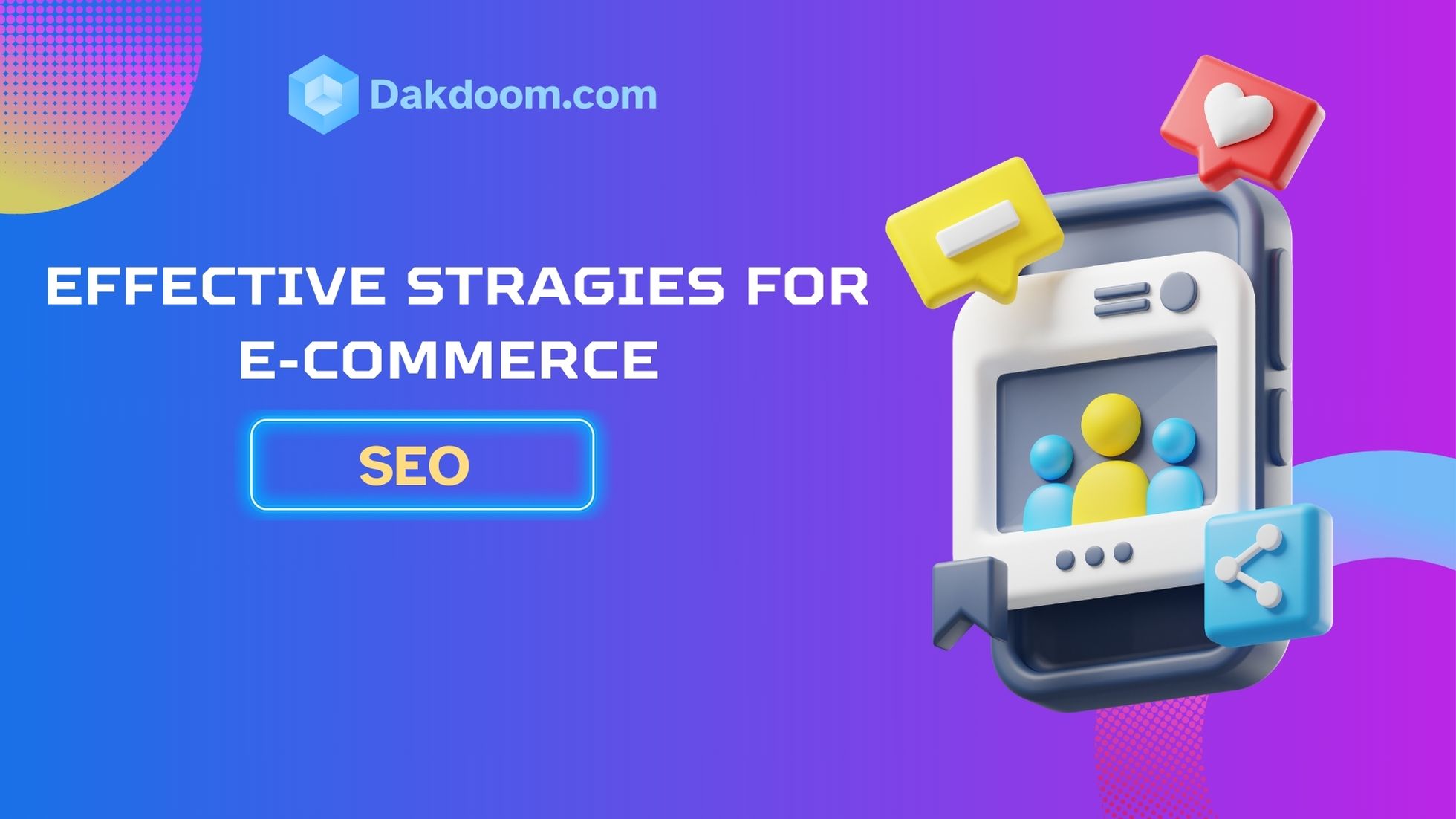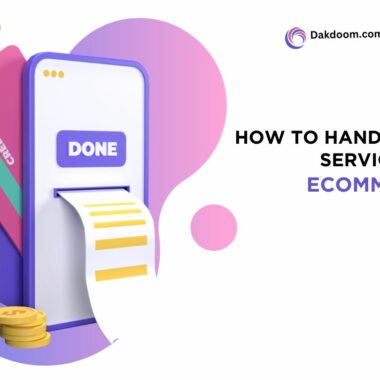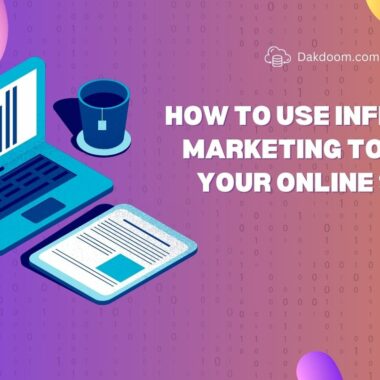Effective Strategies for E-commerce SEO
In the highly competitive world of e-commerce, having a well-optimized website is crucial for driving traffic, increasing sales, and outperforming your competitors. For your website, Dakdoom.com, implementing effective SEO strategies can significantly enhance your online presence. Here’s a comprehensive guide to boosting your e-commerce SEO and ensuring your website stands out in search engine results.

1. Conduct Thorough Keyword Research
Why It Matters: Keywords are the foundation of SEO. They help search engines understand what your website is about and match it with user queries.
Strategies:
- Identify Primary and Long-Tail Keywords: Use tools like Google Keyword Planner, Ahrefs, or SEMrush to find keywords relevant to your products. Focus on both broad terms and specific long-tail keywords that reflect user intent.
- Analyze Competitor Keywords: Look at what keywords your competitors are ranking for and identify gaps you can exploit.
- Optimize Product Listings: Integrate these keywords naturally into product titles, descriptions, and meta tags.
2. Optimize Product Pages
Why It Matters: Product pages are crucial for e-commerce SEO. They are often the first point of contact between potential customers and your website.
Strategies:
- Unique Product Descriptions: Avoid using manufacturer descriptions. Write unique, engaging content that highlights the features, benefits, and uses of each product.
- High-Quality Images: Use high-resolution images and include descriptive alt text with relevant keywords.
- Schema Markup: Implement structured data (schema markup) to help search engines understand product details, such as price, availability, and reviews.
3. Improve Site Architecture and Navigation
Why It Matters: A well-structured site helps search engines crawl your website more efficiently and enhances the user experience.
Strategies:
- Create a Logical Hierarchy: Organize your site into clear categories and subcategories. Use breadcrumb navigation to improve usability.
- Internal Linking: Use internal links to connect related products and content. This helps distribute page authority and keeps visitors engaged.
- XML Sitemap: Generate and submit an XML sitemap to search engines to ensure all pages are indexed.
4. Focus on Mobile Optimization
Why It Matters: With the increasing number of mobile shoppers, having a mobile-friendly site is essential for both user experience and SEO.
Strategies:
- Responsive Design: Ensure your website is responsive and adapts to different screen sizes.
- Page Speed: Optimize images and reduce unnecessary scripts to improve loading times on mobile devices.
- Mobile Usability: Test your site on various devices to ensure a smooth shopping experience.
5. Enhance User Experience (UX)
Why It Matters: A positive user experience can reduce bounce rates, increase dwell time, and boost conversions.
Strategies:
- Simplify Navigation: Make it easy for users to find products through intuitive navigation and search functions.
- Streamline Checkout Process: Minimize steps in the checkout process to reduce cart abandonment.
- Provide Clear Calls to Action (CTAs): Use prominent, actionable buttons to guide users toward purchasing or contacting you.
6. Build High-Quality Backlinks
Why It Matters: Backlinks from reputable sites can boost your domain authority and search engine rankings.
Strategies:
- Content Marketing: Create valuable content such as blog posts, guides, and infographics that other websites want to link to.
- Outreach: Reach out to industry influencers, bloggers, and journalists for guest posts or collaborations.
- Monitor Backlinks: Use tools to track your backlink profile and disavow any low-quality links.
7. Utilize Local SEO Tactics
Why It Matters: If you have a physical store or serve specific geographic areas, local SEO can help attract local customers.
Strategies:
- Google My Business: Set up and optimize your Google My Business listing with accurate information, photos, and customer reviews.
- Local Keywords: Incorporate local keywords into your product descriptions and meta tags.
- Local Listings: Ensure your business is listed in local directories and review sites.
8. Monitor and Analyze Performance
Why It Matters: Regularly tracking your SEO performance helps you understand what’s working and where improvements are needed.
Strategies:
- Use Analytics Tools: Tools like Google Analytics and Google Search Console provide insights into traffic, user behavior, and search performance.
- Track Key Metrics: Monitor metrics such as organic traffic, bounce rate, conversion rate, and keyword rankings.
- Adjust Strategies: Based on performance data, refine your SEO strategies to improve results.
9. Leverage Content Marketing
Why It Matters: Content marketing not only drives traffic but also establishes your brand as an authority in your industry.
Strategies:
- Blogging: Regularly publish blog posts related to your products, industry trends, and customer interests. Aim to answer common questions and provide valuable insights.
- Guides and Tutorials: Create in-depth guides, how-to articles, and tutorials that help your audience use your products more effectively.
- Video Content: Develop product demos, unboxings, and customer testimonials. Video content can improve engagement and time spent on your site.
10. Optimize for Voice Search
Why It Matters: Voice search is growing in popularity, and optimizing for it can help capture a new segment of search traffic.
Strategies:
- Natural Language: Use conversational and natural language in your content, as voice search queries are often more natural and question-based.
- Featured Snippets: Structure content to answer common questions directly, aiming to appear in featured snippets.
- Local Optimization: Voice searches often have local intent, so optimize for local keywords and ensure your Google My Business listing is accurate.
11. Implement A/B Testing
Why It Matters: A/B testing helps you determine which changes to your site lead to better performance, including improved SEO metrics.
Strategies:
- Test Headlines and Descriptions: Experiment with different product titles and descriptions to see which versions perform better in terms of click-through rates and conversions.
- Evaluate User Experience Changes: Test different layouts, navigation options, and CTA placements to find what enhances user experience.
- Analyze Results: Use tools like Google Optimize or Optimizely to track results and make data-driven decisions.
12. Enhance Site Security
Why It Matters: Site security is crucial for user trust and search engine rankings. Google considers HTTPS as a ranking factor.
Strategies:
- SSL Certificates: Ensure your website has an SSL certificate and is served over HTTPS to protect user data and boost SEO.
- Regular Updates: Keep your site’s software, plugins, and themes updated to avoid vulnerabilities.
- Monitor for Malware: Regularly scan your site for malware and security issues to maintain a safe browsing experience.
13. Focus on User Reviews and Ratings
Why It Matters: User reviews and ratings can enhance credibility, improve click-through rates, and contribute to better rankings.
Strategies:
- Encourage Reviews: Prompt customers to leave reviews after purchases. Consider offering incentives for feedback.
- Respond to Reviews: Engage with customers by responding to reviews, addressing concerns, and thanking them for positive feedback.
- Showcase Reviews: Display customer reviews prominently on product pages and use structured data to enhance visibility in search results.
14. Optimize for International SEO (if applicable)
Why It Matters: If you’re targeting a global audience, international SEO ensures your content is relevant and accessible to users in different regions.
Strategies:
- Hreflang Tags: Use hreflang tags to signal to search engines which language and regional variations of your content should be displayed.
- Localize Content: Tailor content to the cultural and linguistic preferences of different regions. This includes translating product descriptions and adapting marketing messages.
- Regional Domains: Consider using country-specific domains (e.g., .uk for the United Kingdom) or subdirectories (e.g., dakdoom.com/uk) for better local targeting.
15. Utilize Social Media for SEO
Why It Matters: Social media can drive traffic to your site and indirectly influence SEO through engagement and brand visibility.
Strategies:
- Share Content: Promote your blog posts, product pages, and special offers on social media platforms.
- Engage with Followers: Build a community around your brand by responding to comments, participating in conversations, and sharing user-generated content.
- Social Signals: Encourage social sharing of your content, as increased visibility and engagement can positively impact SEO.
16. Analyze and Optimize Conversion Rates
Why It Matters: Improving conversion rates ensures that the traffic you drive to your site turns into sales, making your SEO efforts more effective.
Strategies:
- Conversion Rate Optimization (CRO): Analyze user behavior using heatmaps and user recordings to identify areas for improvement.
- Clear CTAs: Ensure your calls to action are clear, compelling, and strategically placed to guide users toward making a purchase.
- Simplify Forms: Reduce the number of fields in forms and make the checkout process as seamless as possible to increase conversion rates.
17. Monitor Algorithm Updates
Why It Matters: Search engines frequently update their algorithms, which can impact your rankings. Staying informed helps you adapt your SEO strategies accordingly.
Strategies:
- Stay Updated: Follow SEO news and updates from reputable sources like Google’s Search Central Blog and industry publications.
- Analyze Impact: Evaluate how algorithm changes affect your site’s performance and adjust your strategies to align with the latest best practices.
Conclusion
By integrating these advanced e-commerce SEO strategies into your approach, Dakdoom.com can achieve a competitive edge in the online marketplace. From leveraging content marketing and optimizing for voice search to enhancing site security and analyzing conversion rates, each strategy contributes to building a more robust and effective SEO presence. Keep monitoring your performance, stay adaptable, and continuously refine your tactics to ensure long-term success in the dynamic world of e-commerce SEO.











